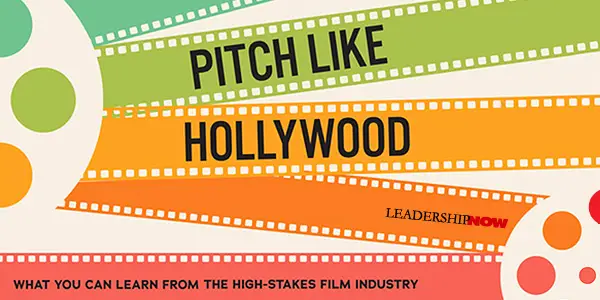 |
 |
04.08.22

Pitch Like Hollywood
HOLLYWOOD is a tough place to pitch. In Pitch Like Hollywood, clinical psychologist Peter Desberg and writer/producer Jeff Davis take us inside to understand the process. “Hollywood has its own form of pitching,” they write. “It employs the traditional elements of pitching used in business but adds other elements to make it more persuasive and emotionally engaging.” Hollywood pitches use characters and conflicts to tell stories that leave audiences needing to know more, Hollywood artists have been pitching the same product for over a hundred years. Give creatine people a quick hundred years, and it’s not surprising that they develop a unique type of pitch. And we can learn from that and incorporate it into what we do every day to influence others for better outcomes. In a world where not-so-good ideas are being listened to way too much, we need a better way to get our ideas heard (provided they are good ones!). A pitch is when you are trying to promote an idea, a business project, or a script. It is the essence of influence. The pitch is a solution to a problem. If you don’t have a problem to solve, there’s no need to pitch. But you are not trying to sell. You are trying to start a conversation. The best pitches use a three-act structure. The pitch should have a hook and a logline. A hook is designed to grab your attention. They are short, engaging, memorable, and unusual. The logline is a short description of the idea you’re presenting. It introduces the protagonist and the antagonist, introduces the main conflict, and gives a hint of the arc. At first blush, it may seem like pitching a story is very different than pitching a business idea. A Hollywood pitch begins by presenting the world as it is: “What products in your field already exist? What service do they perform well? What don’t they do? What are they missing? With this last question, you are laying out your idea in context with the accompanying challenges and problems involved in implementing it.” In Act I, present the “setting for the problem or situation that your idea will solve by providing two key pieces of information. First, you want to orient your audience by laying out the problem area your project will resolve. Second, you introduce the source of conflict. This lets your audience know what problems must be overcome and stimulates their curiosity making them want to hear more.” Act II “deals with previous attempts to resolve the conflict, laying out the problems that were encountered. The emphasis is on problems rather than solutions, making it appear that it’ll be difficult to work things out. The goal is to maximize the audience’s curiosity and add a bit of surprise. Act III “ties everything together. You demonstrate how the conflict is resolved, and your audience hears your data in context as the solution to the problem you introduced at the beginning. If you’ve done your job well and told a great story, your audience will want to see your business plan.” The goal of pitching is collaboration. If you give too little or too much detail, you don’t allow others to get in on it. “When you’re pitching an idea, try to draw people into it. Encourage them to contribute their ideas and show enthusiasm for those ideas. It’s a sign that they’re stimulated by your ideas and want to get involved.” The former president of Hughes Entertainment explains how to avoid excessive detail this way. Imagine you’re at the coffee machine talking to your coworkers on Monday morning telling them about this great movie you saw over the weekend: You’re sharing the cool things about the movie you saw. The things that caught your imagination; the things you remember. You’re sharing the excitement. For me, that’s the key to pitching. If you start throwing in too many details your coworkers will duck for cover on Monday mornings when they see you walking down the hall. When you are called in to give your pitch, and they begin with, “Tell me a little bit a bit yourself,” you don’t want to start reeling off facts about your life. “It shows a considerable poverty of imagination.” Instead, you want to start a conversation, not rehash your credits. In creating your elevator story, it is important too, to know what to leave in and what to leave out of your pitch. A man and a woman are chatting at a cocktail party. The man asks, “What do you do?” To get into the minds of your listeners, when presenting something—especially something new—you need to connect it with something they already know. “The more original your idea is, the tougher it may be to sell, because there isn’t a precedent to show it can work. Improve your pitch by using a similar context and examples of successful precedents, but also by showing the point of departure.” The authors cover the psychology and art of persuasion and the panic that can set in before the presentation, the stage fright you feel when presenting, with informative expert examples and exercises to help you work through the issues. 
Posted by Michael McKinney at 10:10 AM
|
BUILD YOUR KNOWLEDGE
 

How to Do Your Start-Up Right STRAIGHT TALK FOR START-UPS 
Grow Your Leadership Skills NEW AND UPCOMING LEADERSHIP BOOKS 
Leadership Minute BITE-SIZE CONCEPTS YOU CAN CHEW ON 
Classic Leadership Books BOOKS TO READ BEFORE YOU LEAD |